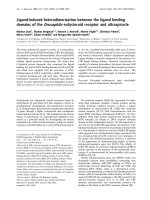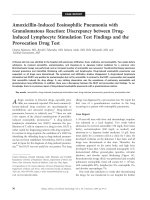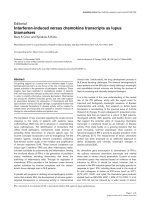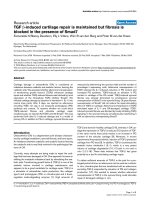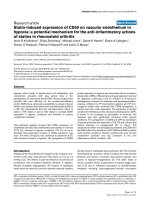Báo cáo y học: " Mild induced hypothermia after out-of-hospital cardiac arrest: persisting doubts about patient safet" pps
Bạn đang xem bản rút gọn của tài liệu. Xem và tải ngay bản đầy đủ của tài liệu tại đây (36.02 KB, 2 trang )
Page 1 of 2
(page number not for citation purposes)
Available online />In a study of the endovascular cooling system Alsius
CoolGard™ combined with the Icy™ venous catheter, Pichon
and colleagues concluded the effectiveness and safety of
mild induced hypothermia (MIH) after out-of-hospital cardiac
arrest resuscitation [1]. We are troubled because the study
has reproduced several safety concerns about MIH that have
not been confronted.
First, the sixfold increase of the nosocomial bloodstream
infection rate (13% versus control 2%) is most probably
related to insertion of endovascular catheters for MIH [1].
Bloodstream infection in patients with endovascular catheters
can become a significant cause of preventable morbidity and
mortality [2].
Second, it is unclear why hypokalemia (75% of MIH cases)
was dismissed as a factor for the incidence of cardiac
dysrhythmia [1]. Temperature changes induce electrolyte
shifts and thus influence the depolarization and repolarization
times and the conduction velocity of action potentials within
the myocardium, promoting aberrant conduction pathways.
Electrolyte abnormalities associated with MIH can influence
electrophysiological parameters of the myocardium, triggering
dysrhythmia [3].
Third, it can be argued that MIH may have contributed to
refractory cardiogenic shock and early death. MIH blunts the
myocardial response to inotropic medications and increases
the requirement for vasopressors to maintain hemodynamic
stability [4]. The survival benefit for out-of-hospital cardiac
arrest from an early intervention for coronary reperfusion and
restoration of optimal cardiac performance substantially
exceeds the survival benefit from MIH [5].
Fourth, MIH can prolong and augment the activation of
inflammatory cytokines [6]; manifesting with rebound
hyperthermia upon re-warming (74% of MIH cases) [1]. The
cytokine response to MIH can diminish the favorable neuro-
protective effect, and can perhaps exacerbate acute organ
injury.
Fifth, the concurrent use of muscle relaxants in MIH may
conceal clinical signs of epileptic activity after cardiopulmonary
resuscitation and hypoxic insult to the brain. Continuous
monitoring of the electroencephalogram is necessary to
detect and treat provoked epileptic activity, otherwise
secondary neuronal injury can progress during MIH [7].
Immediate neurophysiologic studies after cardiopulmonary
resuscitation suggest that MIH has a limited therapeutic
benefit for neurologic salvage or protection [8].
It is imperative to recognize that MIH as a treatment modality
after cardiopulmonary resuscitation has a narrow safety
margin, and its misapplication can lead to unintended
deleterious consequences [9]. Pichon and colleagues
highlight several safety concerns that must be addressed
before recommending the broad application of endovascular
cooling devices in clinical practice.
Letter
Mild induced hypothermia after out-of-hospital cardiac arrest:
persisting doubts about patient safety
Bhavesh M Patel, Alyssa B Chapital, Mohamed Y Rady and Joel S Larson
Department of Critical Care Medicine, Mayo Clinic Hospital, Mayo Clinic Arizona, 5777 East Mayo Boulevard, Phoenix, AZ 85054, USA
Corresponding author: Mohamed Y Rady,
Published: 27 August 2007 Critical Care 2007, 11:420 (doi:10.1186/cc6084)
This article is online at />© 2007 BioMed Central Ltd
See related research by Pichon et al., />MIH = mild induced hypothermia.
Authors’ response
Nicolas Pichon and Bruno François
We assent to the potential relationship between the develop-
ment of nosocomial bloodstream infection and MIH, and
future specific studies may provide clarity about this
relationship. Moreover, we agree that hypothermia probably
Page 2 of 2
(page number not for citation purposes)
Critical Care Vol 11 No 4 Patel et al.
induces electrolyte shifts, but the literature demonstrates that
the influence of electrolyte disorders on potential dysrythmia
and the risk of arrhythmias increase significantly when the
temperature drops below 30°C, which is not the case in our
study [10,11]. Concerning the cardiogenic shocks, MIH may
have contributed to worsening hemodynamics and therefore
should not be induced in these patients until further data are
available. Two studies, however, have demonstrated that MIH
seems beneficial in these conditions [4,12]. The endo-
vascular cooling system does not exclude an early inter-
vention for coronary reperfusion, and the association of MIH
and coronary reperfusion may increase the survival rate [12].
The ‘rebound hyperthermia’ frequently observed after rewarming
may decrease the beneficial effects of MIH on brain injury and
has not yet been clearly explained [10]. An additional use of the
cooling system (target temperature of 37°C for several hours)
after rewarming appears an efficient technique to avoid
‘rebound hyperthermia’ and the activation of inflammatory
cytokines, but deserves further study (unpublished data).
Hypothermia alone significantly reduces the number of and
the severity of motor seizures, and exhibits anticonvulsant
effects in addition to the large use of benzodiazepines for
sedation [13].
Even if several safety concerns remain to be investigated,
none of the adverse effects result in a worsened outcome. In
addition, the beneficial effect of the endovascular cooling
system by far exceeds the complications.
Competing interests
The authors declare that they have no competing interests.
References
1. Pichon N, Amiel JB, François B, Dugard A, Etchecopar C, Vignon
P: Efficacy and tolerance of mild induced hypothermia after
out-of-hospital cardiac arrest using an endovascular cooling
system. Crit Care 2007, 11:R71.
2. Pronovost P, Needham D, Berenholtz S, Sinopoli D, Chu H, Cos-
grove S, Sexton B, Hyzy R, Welsh R, Roth G, et al.: An interven-
tion to decrease catheter-related bloodstream infections in
the ICU. N Engl J Med 2006, 355:2725-2732.
3. Sprung JMDP, Laszlo AMD, Turner LAMD, Kampine JPMDP,
Bosnjak ZJP: Effects of hypothermia, potassium, and vera-
pamil on the action potential characteristics of canine cardiac
purkinje fibers. Anesthesiology 1995, 82:713-722.
4. Oddo M, Schaller MD, Feihl F, Ribordy V, Liaudet L: From evi-
dence to clinical practice: effective implementation of thera-
peutic hypothermia to improve patient outcome after cardiac
arrest. Crit Care Med 2006, 34:1865-1873.
5. Werling M, Thoren AB, Axelsson C, Herlitz J: Treatment and
outcome in post-resuscitation care after out-of-hospital
cardiac arrest when a modern therapeutic approach was
introduced. Resuscitation 2007, 73:40-45.
6. Fairchild KD, Singh IS, Patel S, Drysdale BE, Viscardi RM, Hester
L, Lazusky HM, Hasday JD: Hypothermia prolongs activation of
NF-kappaB and augments generation of inflammatory
cytokines. Am J Physiol Cell Physiol 2004, 287:C422-C431.
7. Hovland A, Nielsen EW, Kluver J, Salvesen R: EEG should be
performed during induced hypothermia. Resuscitation 2006,
68:143-146.
8. Sakurai A, Kinoshita K, Moriya T, Utagawa A, Ebihara T, Furukawa
M, Tanjoh K: Reduced effectiveness of hypothermia in patients
lacking the wave V in auditory brainstem responses immedi-
ately following resuscitation from cardiac arrest. Resuscitation
2006, 70:52-58.
9. Merchant RM, Abella BS, Peberdy MA, Soar J, Ong ME, Schmidt
GA, Becker LB, Vanden Hoek TL: Therapeutic hypothermia
after cardiac arrest: unintentional overcooling is common
using ice packs and conventional cooling blankets. Crit Care
Med 2006, 34(12 Suppl):S490-S494.
10. Polderman KH: Application of therapeutic hypothermia in the
intensive care unit: opportunities and pitfalls of a promising
treatment modality. Part II: practical aspects and side effects.
Intensive Care Med 2004, 30:757-769.
11. Hypothermia after Cardiac Arrest Study Group: Mild therapeutic
hypothermia to improve the neurologic outcome after cardiac
arrest. N Engl J Med 2002, 346:549-556.
12. Hovdenes J, Laake JH, Aaberge L, Haugaa H, Bugge JF: Thera-
peutic hypothermia after out-of-hospital cardiac arrest: expe-
riences with patients treated with percutaneous coronary
intervention and cardiogenic shock. Acta Anaesthesiol Scand
2007, 51:137-142.
13. Schmitt FC, Buchheim K, Meierkord H, Holtkamp M: Anticonvul-
sivant properties of hypothermia in experimental status
epilepticus. Neurobiol Dis 2006, 23:689-696.
